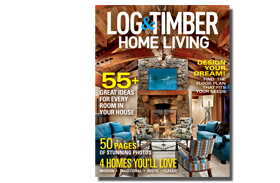

Kitchens are the nerve center of a home, serving purposes as diverse as paying bills to hosting parties — not to mention daily meal prep.
Given the spectrum of tasks a kitchen must accommodate, it’s no wonder that there’s been a shift from the “triangle” design concept (placing the stove, refrigerator and sink at each point) to “zone” design, which arranges appliances and storage in groupings based on task.
However, two new, very important trends are now dominating the kitchen-creation scene: improved utility and enhanced hygienics.
Michael Grant, a partner in Modern Rustic Homes, which specializes in log, timber frame and mountain-style architecture, says that these important pieces of the kitchen puzzle have been trending for a few years. But as the Covid-19 pandemic forced us inside for extended periods of time, it caused us to take a sudden, sharp look at the way our homes function, as well as how sanitary they are.
New Energy Works interior/architectural designer Diana Gerken agrees, saying that when it comes to crafting kitchens, cleanability and durability are high on their timber frame home customers’ must-have lists.
So, how can you incorporate these principles into your log or timber home plans? Our two experts recommend design ideas and materials that can boost your kitchen’s performance — and look spectacular in the process.


Practice Good Kitchen Hygiene
Michael, whose homes are built primarily in the southeastern United States, and Diana, whose designs are constructed throughout North America, are both seeing the same major trend: quartz countertops are all but replacing granite and other natural stones.
“Synthetic-stone surfaces are non-porous, so they don’t harbor bacteria, while granite and marble do,” Michael says, adding that quartz has other advantages such as a wider range of color options, scratch and heat resistance and nearly no maintenance.
Diana shares that in addition to quartz, her clients also want stainless steel countertops, particularly on islands, for their easy cleanup and resistance to germs.
The need for cleanliness doesn’t stop at counters. Diana says buyers also try to minimize or eliminate grout lines in backsplashes (which can be tricky to keep tidy), so they are turning to large-format tiles, pressed-tin panels or even quartz slabs. “Quartz is better suited for a slab backsplash than granite because you can slice it into a thinner sheet — as thin as 1/4- to 3/8-inch thick. You won’t have a heavy slab that protrudes from the wall,” she says.
Her clientele favors wood cabinetry, so to keep it as hygienic as possible, they turn to commercial-grade finishes with a topcoat, which resist stains and are easy to wipe clean, though she says the type of wood you choose also has an impact.
“Wood texture can affect cleanability,” she explains. “We use quite a bit of reclaimed wood, which is environmentally conscious but often has a lot of texture and is harder to clean. If a smooth, cleanable surface is important, we will look to fresh-sawn wood with a tight grain, like cherry or walnut.”
For his customers’ cabinets, Michael says he’s fielding more requests for glass-fronted and even metal units – which are both non-porous surfaces that resist bacteria.
For flooring, concrete is the most sterile option out there, but it’s hard underfoot and is unforgiving to dropped dishware. For a floor covering that’s durable, non-microbial and all-natural, Diana suggests Marmoleum, advising us to ignore the stigma that comes with the idea of “linoleum.” This is a vastly improved product that comes in a range of colors and very realistic patterns, including wood grain and stained concrete, that perfectly complements log and timber homes.


There’s No Futility in Extra Utility
As open-concept floor plans continue to rule residences, designers are getting more creative as to how they combine practicality with aesthetics.
“Kitchen islands are getting bigger for a reason,” says Michael, whose daughter, Allegra, is a professional chef. “It’s not unusual to have your main sink, food prep area, a dishwasher or two and a wine or beverage refrigerator in its base — not to mention seating for guests,” he says. “To maximize its function, we install built-ins for storing wine or cookbooks on the ends.”
When it comes to appliances, more custom homeowners are going professional-grade. Not only are they works of art, their high level of performance improve the utility of what’s arguably the most frequently used room in the house.
But for all the extra goodies you can bake into kitchen design, if you don’t have functional storage, you’ll likely be disappointed. This starts with the pantry. Butler’s pantries that double as serving stations or wet bars have seen a resurgence in popularity in recent years, but a pantry doesn’t have to be huge to be efficient.
“I can’t think of a project we’ve done that doesn’t have a walk-in or step-in pantry,” Diana says. “To maximize wall space, use a mix of deep shelves and drawers along with narrow shelving, which prevents canned goods and other small items from getting lost in the back.”
Michael agrees, suggesting multiple pantries to separate food from dishware and small appliances — even things like an overflow fridge, ice maker or standing freezer. “It’s all about convenience,” Michael explains. “We tend to use only those items that we can access easily.”
In the end, no homeowner has ever complained about having a kitchen that’s too clean or well organized. Thoughtful contemplation about your lifestyle and guidance from a skilled designer will help you achieve both.


Go With the Zone
As kitchens move from the standard stove/sink/fridge triangle footprint to a zone (baking, beverage, food prep, cleanup) configuration, they’re less templated and more personalized. It’s essential you evaluate how your family will function here, then design it to suit your daily life.
Consider these zones as you craft your log or timber home’s kitchen:
Cooking Zone
Uses: Daily meal preparation
Essentials: Oven(s), cooktop, warming drawer, pots and pans storage, pot filling faucet, counter space topped with a scorch-resistant surface
Baking Zone
Uses: Baking and other food prep
Essentials: A lowered countertop (7 to 8 inches below the 36-inch standard, depending on your height) for ergonomic kneading topped with marble or quartz, a mixer-lift tucked in the cabinetry and narrow pullout shelving for extracts and spices
Food Prep Zone
Uses: Cleaning and chopping food
Essentials: Ample counter space (including a butcher block), refrigerator, small sink, specialized drawers for knives/gadgets, storage for dishware, concealed trash/compost receptacles
Cleaning Zone
Uses: Cleanup
Essentials: A deep sink, dishwasher (two if you have frequent, large parties), concealed receptacle for food waste, a window above the sink (to make dreaded dish washing more pleasant)
Family Zone
Uses: Casual dining, homework, intimate get-togethers
Essentials: A central, oversized island or peninsula with under-counter seating, beverage mini-fridge and grab-and-go snack storage
Office Zone
Uses: Bill paying, recipe curating, drop center
Essentials: A nook containing a small desk or counter for your computer, space for a chair, a charging station and built-in shelves/cubbies for organization
Beverage Zone
Uses: Coffee station, wine/beer center
Essentials: Refrigeration suited to your beverage of choice (wine fridge, kegerator, etc.), a stain-resistant surface, appropriate appliances, storage for glasses, mugs, tools/gadgets
See more on log home kitchen design:





